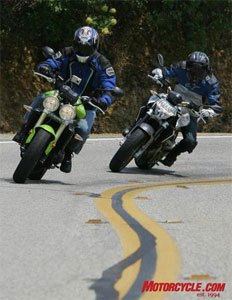Group Riding 101
Group riding is a whole other endeavor compared to solo riding. Where it is like solo riding is that some riders may instinctively do a good job of quickly figuring out the way to do it well, enjoy themselves, and have no issues. Others have found out the hard way that there are new rules to be observed when riding collectively.
“Group riding” is actually a catchall term. More specifically, are you and a few friends planning a day trip on your cruisers or a mixture of bike types? Are you and some friends heading across country? Are you and 11 other strangers riding a guided tour through new environs? Are you and some buddies and your hot sportbikes going out to look for some fun?
| Allstate Insurance On Rider Safety |
Our friends at Allstate Motorcycle Insurance know a thing or two about motorcycle safety. In addition to Motorcycle.com's safety series, Allstate Motorcycle Insurance has its own valuable safety information to share. * Motorcycle Awareness: Safety Tips from Allstate Motorcycle Insurance |
In other words, who is in your group? Do you know everyone and their habits well? Is everyone sufficiently experienced? Or are you riding with novices trying to keep with a herd for the first time in traffic?
Are you new to riding? If you are, think twice. Riding with a group presents challenges to an already demanding learning process, and probably should be avoided until you have at least 1,000 miles experience.
But even assuming you are up for it, depending on the dynamics, and number of riders, it will be necessary to pay greater heed to some fundamentals.
A truly organized ride is of necessity a tamer endeavor. Usually, the most experienced two riders will want to play leader and sweeper (the sweeper rides in last place to look out for stragglers). The leader sets the pace, but before even starting out, everyone in the group ought to do a few things to help make sure you all stay on the same page.
First, is everyone's bike fueled up? Has each rider done a pre-ride check?
If you break down ten miles into it, you'll put a damper on everyone's day.
The leader's job is to sets the rules. There is a variety of pretty standard hand signals, and it's a good idea to have everyone agree up front on the ones you'll be observing. This will minimize confusion.
Exchanging cell phone numbers with the leader is also advisable in the event someone gets lost or has a problem. If it's possible to utilize an intercom between lead and sweep or others in the group, that also can help keep things together. Another good idea is sending out the route in advance via email with a GPS route attached. The directions could then be printed, and placed in a map holder on your tank, or other convenient location.
According to the Motorcycle Safety Foundation, a standard formation is staggered, giving everyone enough room to negotiate the road. The leader typically rides in the left third of the lane, followed by the next rider at least one second behind in the right third of the lane, and so on alternating and evenly at about one second intervals. In inclement weather, a larger space cushion is advisable. On narrow or curvy roads, a single-file formation is advisable with more space between bikes.
Groups larger than five to eight riders, while impressive to behold, are not always such a terrific idea. More riders mean more variables for someone to mess up. It also can be intimidating to motorists, and present difficulties in passing situations either for your group to pass a driver, or for motorists to pass you.
Larger groups can create other awkward or hazardous situations besides. For example, if a column of 20 motorcycles is dominating the right lane of a highway, a car driver in the left lane wanting to make a hasty exit may do something risky in trying to get off the road in time.
If you have many riders, breaking into more manageable sub-groups may be the way to go. Keep in mind, while there is strength in numbers, large groups do not have right of way or own the road in any sense.
Other standard procedures are, when exiting a highway or coming to a tollbooth, it's recommended you go single file. Likewise, in corners, do not go side-by-side for obvious reasons.
When taking off from a light, your group should be fairly close together, but not too close. Each rider should go one after the other. All riders should not leave as a group at the exact same time, but in staggered formation. Leaving a light or stop sign as a single cluster may be illegal depending on local laws, and could get you a ticket.
Another pointer to help avoid some of the bad habits riders can get into when in a herd: When the lead rider correctly stops and goes from a stop sign, that does not mean he stopped for the riders near him. Each rider needs to do the same thing as an individual.
Whether at intersections, in the twisties, the highway, or no matter where you are, there is one cardinal rule when riding in a group of any size: always ride your own ride!
In short, exercising restraint, common sense and respecting everyone's space helps create a rhythm, builds trust, and is part of the art of making this all work.
Pros and cons
As mentioned, group riding can elicit a good deal of ambivalence with experienced riders. To be blunt, some dislike group rides and recommend against them. Many have stories to tell where someone – even an otherwise highly experienced rider – screwed up and crashed, or took someone out.
No demographic is exempt from these stories either. Cruiser riders or tourists not minding their blind spots, or blithely cornering without leaving enough room for their fellow riders have forced others off the road, or collided.
Packs of sport riders pumped with testosterone are also known as a recipe for craziness. The temptation to use that rocket between your legs can lead you into doing all sorts of things you'd be less likely to do alone when your wits are fully with you.
Regardless what kind of bike you are on, if you find yourself with a sketchy crowd, or are tempted to get in over your head, you ought to just gracefully bow out and save it for another day.
On the positive side, if you can follow the program, and exercise restraint, the camaraderie and fun can add a whole other dimension to your life as a rider.
Another upside to riding with others is, if something goes wrong, you'll have help readily available. Before starting out, each rider could agree to share resources. For example: one person carries a first-aid kit, another a flat repair kit, another could carry a full complement of tools and hopefully have knowledge of what to do with them, etc.
Picking your riding partners should be like picking your friends: Be selective, keep your wits with you at all times, and make sure it is win-win all the way around.
If you do that, then sharing the road can be safe and rewarding.
While some consider group riding good, and others consider it not so good, like a lot of other things in life, it really is what you make of it.
Related Reading
How Well Do You Know Your Motorcycle?
Rider Education, Injuries and Fatalities
What to Wear When You Ride - and Why
The SEE System: Increasing Your Visibility
Motorcycle Insurance Basics
Choose a Motorcycle That Fits
The American Culture of Motorcycle Safety
Should You Ride a Motorcycle
How to Load Your Motorcycle
Night Riding
Riding With a Passenger
Riding in the Rain and Wind
The Truth about Drinking and Riding
Road Conditions Quiz
Knowing How to Brake Saves (the most) Lives
More by Jeff Cobb































Comments
Join the conversation